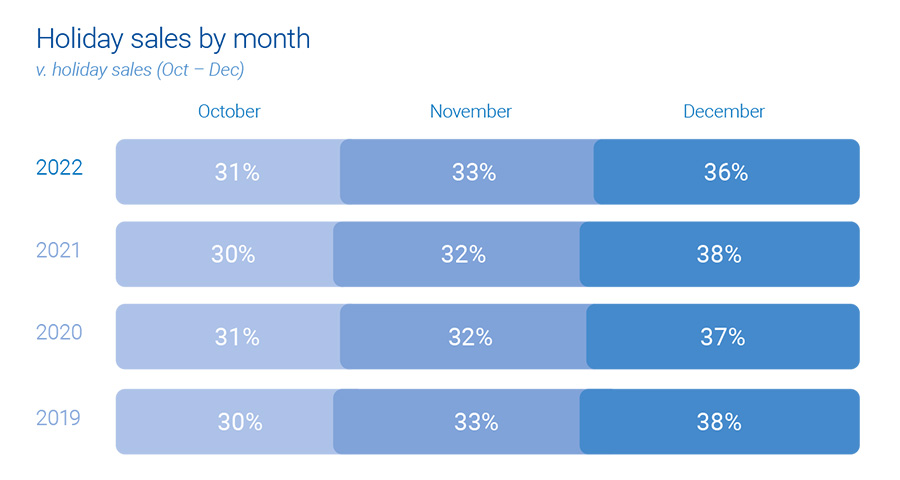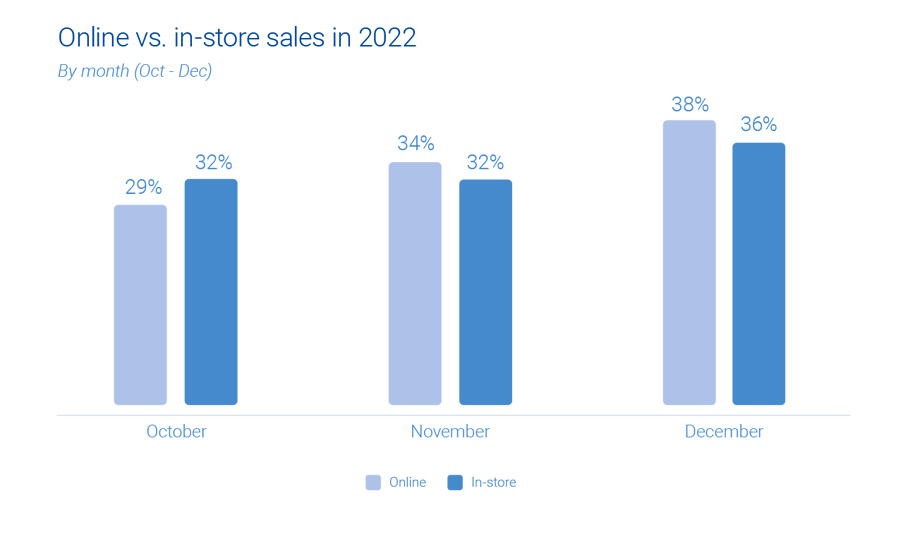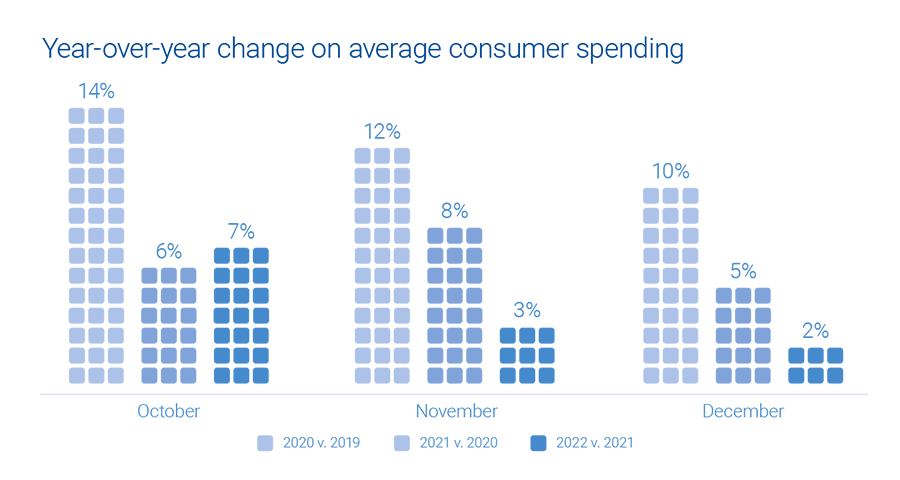
The holiday season is just around the corner, and retailers and marketers are gearing up for the busiest shopping period of the year. It’s crucial to understand how consumer behavior is evolving and what emerging trends to expect. Experian’s 2023 Holiday spending trends and insights report analyzes recent trends, consumer spending habits, and anticipates what’s to come in 2023 to help you deliver a top-notch shopping experience this holiday season.
In this blog post, we’ll cover three key insights from our report.
1. Consumers are shopping earlier
It’s no secret that December has always been the go-to month for consumers when it comes to holiday spending. However, holiday shopping now starts earlier, particularly with online sales.

This can be attributed to a surge in promotions and deals, enticing shoppers to open their wallets ahead of time, giving a significant boost to holiday sales. Notably, Cyber Week sales have proven to be an influential factor, accounting for 8% of total consumer holiday spending.
Experian tip
Reach the right shoppers with your promotions with sell-side targeting. This powerful approach gives you control over where your ads are placed while ensuring maximum visibility through direct connections with publishers. Whether on mobile, web, or CTV, this seamless ad experience will engage your audience effectively.
2. Online sales are on the rise
The popularity of online holiday sales is continuously growing, surpassing in-store shopping. There has been a consistent 1% year-over-year increase in online sales, while in-store sales have seen a 1% decrease.
“It’s easier for consumers to comparison shop for large ticket items online that they might find at a mass retailer or office supply store. Consumers prefer to have larger, bulkier items shipped directly to their home for minimal cost. By shopping online, consumers can save time since they don’t need to wait in checkout lines.”
Anna Liparoto, Sr. Account Executive, Retail & CPG

Although online sales currently make up only one-third of all holiday shopping, there is immense potential for further expansion. Mass retailers and office, electronics, and games industries particularly excel in online holiday sales. While in-store purchases remain the primary choice for holiday shoppers, consumer online and offline activities intersect before the final purchase.
Experian tip
Take advantage of the surge in online shopping by diversifying your marketing channels. An agnostic identity graph can bring together device and media data, capturing valuable user insights. By gaining a holistic view of your target audience, you’ll be able to optimize your ad spend and allocate resources effectively, ultimately boosting your return on investment.
“Omnichannel targeting during the upcoming holiday season will continue to prove to be the best way to reach scale and maximize ROI across all marketing channels.”
Joe LigÉ, Head of Enterprise Demand Partnerships
3. 2023 holiday spending will be on par with 2022
During the holiday season in 2022, consumer spending showed an anticipated increase, although the growth rate was slightly lower compared to previous years. October saw a surge in average consumer spending, indicating a swift response to early discounts and promotions offered by retailers.

As the holiday season progressed, holiday spending gradually slowed down and reached a level similar to that of the previous year. Overall, there was a modest 2% growth. Looking into the future, if economic conditions remain stable in the second half of 2023, we can expect holiday spending to align with the figures from last year.
Experian tip
To truly maximize impact, consider data enrichment. By diving deeper into your target audience’s preferences and behaviors, you can better tailor your strategies and seamlessly integrate the enriched data across various channels. This allows you to unlock the true potential of your ad inventory, creating more meaningful connections with your audience.
Download our 2024 report
Get ready for the holiday shopping season with Experian’s 2024 Holiday spending trends and insights report. Inside you’ll find:
- Analysis of past trends and what they mean for 2024
- Exclusive predictions for the upcoming holiday season
- The top audiences to activate this holiday season
To access to all of our predictions for this year’s holiday shopping season, download our 2024 Holiday spending trends and insights report today.
Latest posts

Before we get to the gift guides, here’s a brief update on the hottest products from the week including Cyber Monday. This week’s biggest movers and new additions to the list are a clear sign that Christmas is upon us. “Star Shower,” a laser light that bathes your house in festive lights without having to untangle cords, jumped to second place, up 49 rank points from the week prior. Likewise, the return of “Elf on the Shelf” to the hot products list coincides with his return to the homes of children nationwide. Otherwise, things seems to have stabilized with Fitbit showing no signs of falling from first place and Pie Face game being this year’s sensation. Toys Shopkins remains the toy to beat this season followed by Pie Face game, which remained in second place after skyrocketing interest during the week of Thanksgiving. Toys new to the top 10 this week include some old favorites like the Easy Bake Oven and Paw Patrol toys as well as the new entrant Glammin Salon Vanity. Keep checking back each week for the latest hot toys. This chart shows the 10 most searched for toys and games based on search clicks to Toys “R” Us – USA. Gift guide insight When it comes to buying presents for the holidays, some individuals are easy to shop for while others require a bit of inspiration. And when consumers need inspiration, consumers turn to the Web. Searches for “gifts for,” “gift guide” and “gift ideas” grow increasingly common as we get closer and closer to Christmas with peak search activity around this topic typically observed during the last full week before Christmas, which this year would be the week ending Saturday December 19th. Some of the most common gift recipients mentioned in gift guide-related searches are: “men,” “guys,” “her,” “mom,” “dad” and “girlfriend.” But shoppers are also frequently looking for suggestions on the perfect gift for someone very specific interests, such as “hunters,” “gamers” and “beer lovers” as well as specific types of gifts, like “tech” or “personalized.” The following gift guide insights, derived using our new AudienceView platform, were designed to highlight for you, as a marketer, the interests and preferences of key consumer segments so that you can more effectively tailor your campaigns to be more relevant and engaging. But if it also helps you, as a consumer, come up with the perfect gift for that hard-to-shop-for person in your life, then even better! Each gift guide contains a representative mix of search terms that were performed at above average rates by each audience segment during the four weeks ending November 28, 2015. They include a mix of product and retail brands and provide a good idea of the interests, style preferences and lifestyles of each audience. Learn more about how AudienceView can deliver unparalleled insights into your consumer audience so that you can deliver a better brand experience.

It’s October, and you know what that means; leaves are changing, sweaters are being pulled out of the closet, pumpkin-flavored items are taking over coffee shops. For many marketers, this is the most exciting (and stressful) part of the year. Holiday marketing is ramping up, and it will only increase in intensity as the weeks go on. Luckily, we’re hard at work here at Experian, analyzing data from past holiday seasons to bring you the insights you need to make your holiday marketing programs successful. We’ve examined search and email behavior to compile a list of the most important days to email and trends that will help you delight your customers from now until the New Year. You can access all of these insights in our Holiday 2015 Marketing Insights Calendar, which covers marketing trends from October through December. Holiday marketing tips for October With Halloween fast approaching at the end of the month (and Thanksgiving/Black Friday/Cyber Monday not far behind), marketers should use October to solidify their plan for the holiday season. Here are three things you can do to optimize your impact this month: 3 ways to optimize your holiday marketing programs in October Target reactivation campaigns to last year’s holiday-only shoppers to maximize active subscribers this season Perform a data cleanse and email verification to ensure message delivery. List health is key to a successful holiday season, and now is the time to double check. Consider offering Halloween-specific products for the little ones. Costumes for newborns and toddlers are on the rise, so don’t forget about the youngsters! Want more holiday marketing insights? Don’t miss our upcoming webinar, Check your list twice: Last-minute marketing strategies for the holiday season.

Remember when email took the world by storm, replacing a significant portion of “snail mail”? The shift didn’t happen overnight; it took time for the public to understand, trust and embrace the new technology. Advances in digital marketing may move quickly, but we in the industry cannot expect to change user behavior overnight. Consider that email has traditionally been a “one click” or “single action” environment. When a new idea such as kinetic email challenges this convention, there are ways to effectively strategize its use in your campaigns and properly introduce its features to your audience. Kinetic email – the evolution of responsive design You may have heard the energetic term “kinetic” being bounced around – appropriate since movement is the main idea behind this advancement in email communication. But to fully understand its appeal, we need to look back at another technological breakthrough. Once the mobile boom occurred a few years ago, email designers saw the writing on the wall – or perhaps we should say “on the screen” – and responsive design was born. It was finally possible for content and layout to resize to the screen of the device on which it was viewed. In designing those layouts for mobile screen sizes by manipulating the CSS, developers eventually discovered that content in the email could be interactive and dynamic. This capability was coined “kinetic.” Kinetic email design acts as the next stage of responsive, giving the user multiple ways to interact with the content and layout before he or she takes a committed action. Why is it desirable? Studies in user behavior tell us that the average viewer spends 3-15 seconds looking at an email communication, with the average Apple user spending even less – only 0-3 seconds. Obviously, there’s a huge advantage in holding someone’s attention, and if used cleverly, kinetic design can help in that regard. It can also remove steps to purchase because they’re being completed within the email rather than on the website. Within the email, subscribers may be able to view color and size choices, or choose between perks such as free shipping or a percentage off their order (we’ll dig deeper into those possibilities in a follow up blog post). This creates a more interactive atmosphere, and that’s a good thing. Still, you must bear in mind that too many steps provided by kinetic design can be overkill. You don’t want to add more work for the viewer; complicating what was once a simple action can turn off your audience, so be smart about its application. Does it make sense for your brand? The key is to determine whether or not kinetic capabilities complement your brand. What do you offer? Who is your customer base? Remember, an email marketer needs the user to interact with the email; they won’t just hover or toggle instinctively. Will your customers stick around to watch, explore or play? Carefully consider products/images/topics that will offer an engaging experience. It has to result in more than just a “wow” response; in needs to encourage transactions. It can also be difficult to predict response since this sort of breakthrough is likely more exciting to those of us on the development side than it is to the end consumer. To prepare your customers for the novelty of kinetic email, you could notify them in advance. However, a smarter way to approach the introduction might be through the use of simplified tabs and navigation. Too many options would start to look like a full blown site – unnecessary. Is kinetic email the future? It’s a bold innovation for sure, but it’s still too early to determine its value to email marketers. To be truly valuable, it must consistently get people interested in making a selection – and a carousel of pretty pictures only goes so far. A savvy email marketer knows that flashy functionality can be an attention-getter, but it must be used when and where it makes sense. Aim for a smarter execution to make the most of a kinetic set up. Want to learn more about the latest trends in email design? Watch the video recording from our recent webinar, Digital Eye Candy: Email Creative Strategies that Wow!